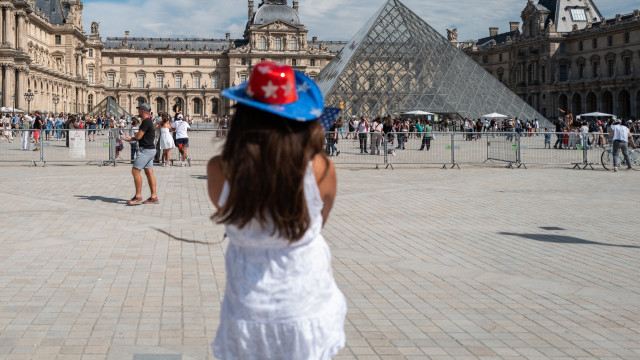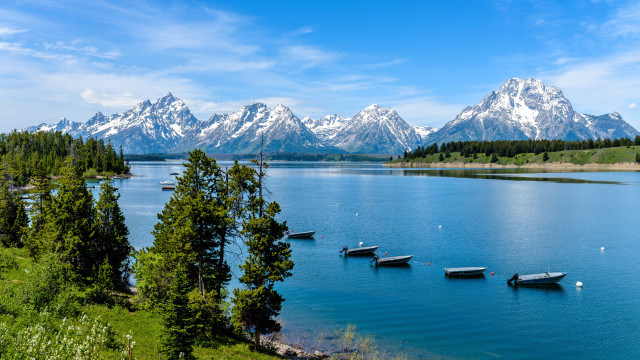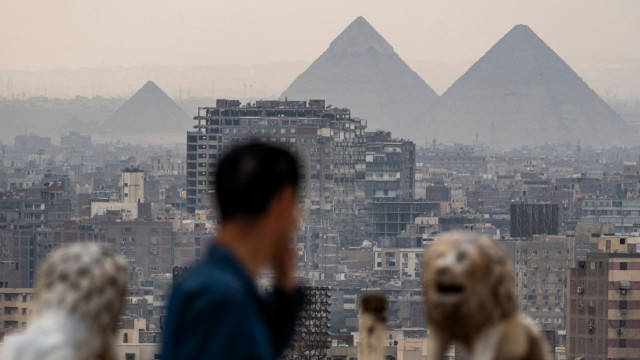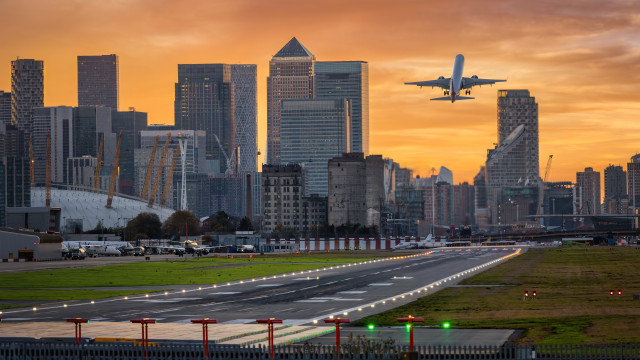































© Getty Images
0 / 32 Fotos
Aphrodisias, Turkey
- Aphrodisias is named for Aphrodite, the Greek goddess of love. Located near the modern village of Geyre in western Anatolia, this remarkably well-preserved archaeological site was once the provisional capital of the region and Roman province of Caria, dating back to around the early 2nd century BCE.
© Getty Images
1 / 32 Fotos
Persepolis, Iran
- The magnificent ruins of Persepolis, an ancient capital of the kings of the Achaemenian dynasty of Iran, rest at the foot of Kuh-e Rahmat (Mountain of Mercy) in the southwest of the country. Built by Darius and his son Xerxes the Great around 500 BCE, the city was sacked by Alexander the Great in 330 BCE.
© Getty Images
2 / 32 Fotos
Petra, Jordan
- One of the world's most famous archaeological sites, Petra is half-built, and half-carved into solid rock. Once a thriving trading center and the capital of the Nabataean empire between 400 BCE and 106 CE, Petra remained "lost" to the Western world until rediscovered in 1812. Pictured is the iconic Al-Khazneh (Treasury).
© Shutterstock
3 / 32 Fotos
Olympia, Greece
- Greece is richly embellished with numerous sites of great historical significance. Olympia, however, is the ruined sanctuary of the ancient Olympic Games, held every four years throughout Classical antiquity, from the 8th century BCE to the 4th century CE.
© Shutterstock
4 / 32 Fotos
Sarmizegetusa Regia, Romania
- Hidden in the dense forests of the Carpathians and often overlooked by tourists, Sarmizegetusa Regia was the capital of the ancient Dacian Kingdom, which flourished from 168 BCE–106 CE. An important military, religious, and political center, the fortress-city served as the core of a strategic defensive system.
© Shutterstock
5 / 32 Fotos
Caral-Supe, Peru
- The archaeological site of Caral-Supe in Peru's arid Supe valley has been attributed an antiquity of 5,000 years, making it the oldest city in the Americas, and one of the oldest in the world. Indeed, Caral developed at the same time as other great cultures in Mesopotamia, Egypt, and China.
© Shutterstock
6 / 32 Fotos
Masada, Israel
- Masada is an isolated ancient mountaintop fortress in southeastern Israel and the site of the Jews' last stand against the Romans after the fall of Jerusalem in 70 CE. Masada is one of the most popular tourist destinations in Israel.
© Getty Images
7 / 32 Fotos
Ellora Caves, India
- The Ellora Caves are an extraordinary rock-cut monastery temple complex located in the Aurangabad district of Maharashtra, India. Regaling visitors are 34 temples, the grandest of which is found in the Kailashanatha Cave (pictured).
© Getty Images
8 / 32 Fotos
Easter Island, Chile - Easter Island or Rapa Nui, as it is known to locals, is a remote dot in the southeastern Pacific Ocean studded with nearly 1,000 monumental statues, called moai, which were created by the early Rapa Nui people, made mostly between c. 1250 and 1500.
© iStock
9 / 32 Fotos
Forum, Italy
- While Rome's mighty Colosseum is the stand-alone star of the show, it is the clustered ruins of the Roman Forum—the nucleus of commercial affairs—that best convey what day-to-day life must have been like in the heart of the empire.
© Shutterstock
10 / 32 Fotos
Ayutthaya, Thailand
- Founded in 1350, the ancient Siamese capital of Ayutthaya is home to a collection of splendid Buddhist temples that feature a decorative array of religious art and artifacts dating back to the 14th century. The location itself is peaceful and tranquil.
© Shutterstock
11 / 32 Fotos
Stonehenge, England
- This unique prehistoric stone circle is one of the most beguiling ancient monuments in the world. Archaeologists believe that Stonehenge was constructed from 3000 BCE to 2000 BCE. It's located on Salisbury Plain in Wiltshire, in south-west England.
© Getty Images
12 / 32 Fotos
Volubilis, Morocco
- The partly excavated Berber-Roman city of Volubilis is situated near the city of Meknes. Founded in the 3rd century BCE, Volubilis is one of the best-preserved ancient sites in the country.
© Shutterstock
13 / 32 Fotos
Aksum, Ethiopia
- Once the seat of the kingdom of Aksum, the archaeological site of Aksum close to Ethiopia's northern border is known today for its collection of tall granite obelisks, a series of intricately inscribed pillars that include the Stele of King Ezana (pictured), carved and erected in the 4th century.
© Getty Images
14 / 32 Fotos
Machu Picchu, Peru
- Perched above the Urubamba River valley in the Andes Mountains, Machu Picchu is the site of ancient Inca ruins. Built around 1450 but abandoned a century later, no Europeans visited the site until 1911.
© iStock
15 / 32 Fotos
Meroe, Sudan
- Pyramids are usually associated with Egypt. But in Meroe, an ancient city on the east bank of the Nile in Sudan, they were building their so-called Nubian pyramids, about two hundred of them in three groups. Most are now sadly ruined, though some have been carefully restored using the traditional materials of granite and sandstone.
© Getty Images
16 / 32 Fotos
Skara Brae, Scotland
- This stone-built Neolithic settlement, located on the Bay of Skaill on the west coast of Mainland, the largest island in the remote Orkney archipelago, is the best-preserved site of its kind in Western Europe. Built 5,000 years before Stonehenge was constructed, Skara Brae was discovered in 1850 after a particularly fierce storm literally unearthed the long-buried prehistoric village.
© Shutterstock
17 / 32 Fotos
Sigiriya, Sri Lanka
- This ancient rock fortress and former royal palace is one of Sri Lanka's most visited and best-known sites. Sigiriya is of great historical and archaeological significance. The location, near the modern-day town of Dambulla, was chosen by King Kashyapa (477–495 CE) for his new capital, selected for its strategic importance and near-impregnable aspect.
© Shutterstock
18 / 32 Fotos
Chichén Itzá, Mexico
- The ruined ancient Maya city of Chichén Itzá in Mexico's south-central Yucatán state was once home to 35,000 people. The Temple of Kukulcán (El Castillo) dominates the center of the archaeological site, the most visited in the country.
© Shutterstock
19 / 32 Fotos
Prambanan Temple Compounds, Indonesia
- Built in the 10th century, Prambanan is the largest temple compound dedicated to Shiva in Indonesia. An icon of the country's cultural heritage, Prambanan numbers over 500 temples, each of which features intricately carved stonework.
© Getty Images
20 / 32 Fotos
L’Anse aux Meadows, Canada
- L’Anse aux Meadows National Historic Site on the island of Newfoundland landmarks the remains of an 11th-century Viking settlement and evidence of their first European presence in North America. The excavated remains of wood-framed peat-turf buildings are similar to those found in Norse Greenland and Iceland.
© Shutterstock
21 / 32 Fotos
Pompeii, Italy
- A cataclysmic eruption of Mount Vesuvius on August 24, 79 CE, smothered the city of Pompeii with burning, choking ash and pumice to seal the fate of this fabled Roman city. The archaeological site remains one of the most significant proofs of Roman civilization in the world.
© Getty Images
22 / 32 Fotos
Abu Simbel, Egypt
- Egypt mesmerizes with its outstanding archaeological treasures, not least the world-famous Giza pyramids complex. But equally impressive for its astonishing grandeur is Abu Simbel, two rock-cut temples located near the border with Sudan, one of which, the Great Temple (pictured), is dedicated to Ramesses II. The other is the temple of Hathor and Nefertari, also known as the Small Temple.
© Shutterstock
23 / 32 Fotos
Chetro Ketl, USA
- Construction of Chetro Ketl, an Ancestral Puebloan great house and archaeological site located in Chaco Culture National Historical Park, New Mexico, began c. 990. The site is regarded as one of the finest examples of ancient Chacoan architecture in the United States.
© Getty Images
24 / 32 Fotos
Mesa Verde National Park, USA
- Mesa Verde National Park in Montezuma County, Colorado, encloses one of the most sacred and best-preserved Ancestral Puebloan archaeological sites in the United States. The dwellings carved into the cliffs date back 1,400 years.
© Shutterstock
25 / 32 Fotos
Tikal, Guatemala
- Tikal represents the largest urban conurbation in the southern Maya lowlands. What was once a city and ceremonial center of the ancient Maya civilization still impresses, its centuries-worn temple, palaces, and monuments surrounded by the Guatemalan rain forest.
© Shutterstock
26 / 32 Fotos
Timgad, Algeria
- Located in the Aurès Mountains of modern-day Algeria, Timgad was established as a military colony by Roman emperor Trajan in 100 CE. It's remote and windswept, but worth making the effort to reach.
© Getty Images
27 / 32 Fotos
Grianan of Aileach, Ireland
- The mysterious Grianán of Aileach crowns a hilltop in Inishowen, County Donegal. Fashioned out of stone, the origins of this remote ringfort date back to the sixth or seventh century CE, and were identified as the seat of the medieval Kingdom of Ailech and one of the royal sites of Gaelic Ireland.
© Shutterstock
28 / 32 Fotos
Segovia, Spain
- Segovia is one of Spain's most appealing cities, especially because of its elevated Roman aqueduct, one of the best-preserved of its kind in the world. It dates to around 112 CE but appears as if put together yesterday.
© Shutterstock
29 / 32 Fotos
Merv, Turkmenistan
- Appearing like some monstrous sliced loaf, the semi-ruined city of Merv was a major Iranian city in Central Asia, on the historical Silk Road, near today's Mary, in modern Turkmenistan. Indeed, it is the oldest and most completely preserved of the oasis cities along the Silk Road trade routes in Central Asia.
© Shutterstock
30 / 32 Fotos
Carthage, Tunisia
- Mighty Carthage is one of the great cities of antiquity. Capital of the ancient Carthaginian civilization, Carthage rivaled Rome in power and prestige. Vestiges of this thriving port and trading center can be admired on the outskirts of Tunis. Sources (National Geographic) (World History Encyclopedia) (Britannica) See also: Things Hollywood gets wrong about ancient societies
© Shutterstock
31 / 32 Fotos
© Getty Images
0 / 32 Fotos
Aphrodisias, Turkey
- Aphrodisias is named for Aphrodite, the Greek goddess of love. Located near the modern village of Geyre in western Anatolia, this remarkably well-preserved archaeological site was once the provisional capital of the region and Roman province of Caria, dating back to around the early 2nd century BCE.
© Getty Images
1 / 32 Fotos
Persepolis, Iran
- The magnificent ruins of Persepolis, an ancient capital of the kings of the Achaemenian dynasty of Iran, rest at the foot of Kuh-e Rahmat (Mountain of Mercy) in the southwest of the country. Built by Darius and his son Xerxes the Great around 500 BCE, the city was sacked by Alexander the Great in 330 BCE.
© Getty Images
2 / 32 Fotos
Petra, Jordan
- One of the world's most famous archaeological sites, Petra is half-built, and half-carved into solid rock. Once a thriving trading center and the capital of the Nabataean empire between 400 BCE and 106 CE, Petra remained "lost" to the Western world until rediscovered in 1812. Pictured is the iconic Al-Khazneh (Treasury).
© Shutterstock
3 / 32 Fotos
Olympia, Greece
- Greece is richly embellished with numerous sites of great historical significance. Olympia, however, is the ruined sanctuary of the ancient Olympic Games, held every four years throughout Classical antiquity, from the 8th century BCE to the 4th century CE.
© Shutterstock
4 / 32 Fotos
Sarmizegetusa Regia, Romania
- Hidden in the dense forests of the Carpathians and often overlooked by tourists, Sarmizegetusa Regia was the capital of the ancient Dacian Kingdom, which flourished from 168 BCE–106 CE. An important military, religious, and political center, the fortress-city served as the core of a strategic defensive system.
© Shutterstock
5 / 32 Fotos
Caral-Supe, Peru
- The archaeological site of Caral-Supe in Peru's arid Supe valley has been attributed an antiquity of 5,000 years, making it the oldest city in the Americas, and one of the oldest in the world. Indeed, Caral developed at the same time as other great cultures in Mesopotamia, Egypt, and China.
© Shutterstock
6 / 32 Fotos
Masada, Israel
- Masada is an isolated ancient mountaintop fortress in southeastern Israel and the site of the Jews' last stand against the Romans after the fall of Jerusalem in 70 CE. Masada is one of the most popular tourist destinations in Israel.
© Getty Images
7 / 32 Fotos
Ellora Caves, India
- The Ellora Caves are an extraordinary rock-cut monastery temple complex located in the Aurangabad district of Maharashtra, India. Regaling visitors are 34 temples, the grandest of which is found in the Kailashanatha Cave (pictured).
© Getty Images
8 / 32 Fotos
Easter Island, Chile - Easter Island or Rapa Nui, as it is known to locals, is a remote dot in the southeastern Pacific Ocean studded with nearly 1,000 monumental statues, called moai, which were created by the early Rapa Nui people, made mostly between c. 1250 and 1500.
© iStock
9 / 32 Fotos
Forum, Italy
- While Rome's mighty Colosseum is the stand-alone star of the show, it is the clustered ruins of the Roman Forum—the nucleus of commercial affairs—that best convey what day-to-day life must have been like in the heart of the empire.
© Shutterstock
10 / 32 Fotos
Ayutthaya, Thailand
- Founded in 1350, the ancient Siamese capital of Ayutthaya is home to a collection of splendid Buddhist temples that feature a decorative array of religious art and artifacts dating back to the 14th century. The location itself is peaceful and tranquil.
© Shutterstock
11 / 32 Fotos
Stonehenge, England
- This unique prehistoric stone circle is one of the most beguiling ancient monuments in the world. Archaeologists believe that Stonehenge was constructed from 3000 BCE to 2000 BCE. It's located on Salisbury Plain in Wiltshire, in south-west England.
© Getty Images
12 / 32 Fotos
Volubilis, Morocco
- The partly excavated Berber-Roman city of Volubilis is situated near the city of Meknes. Founded in the 3rd century BCE, Volubilis is one of the best-preserved ancient sites in the country.
© Shutterstock
13 / 32 Fotos
Aksum, Ethiopia
- Once the seat of the kingdom of Aksum, the archaeological site of Aksum close to Ethiopia's northern border is known today for its collection of tall granite obelisks, a series of intricately inscribed pillars that include the Stele of King Ezana (pictured), carved and erected in the 4th century.
© Getty Images
14 / 32 Fotos
Machu Picchu, Peru
- Perched above the Urubamba River valley in the Andes Mountains, Machu Picchu is the site of ancient Inca ruins. Built around 1450 but abandoned a century later, no Europeans visited the site until 1911.
© iStock
15 / 32 Fotos
Meroe, Sudan
- Pyramids are usually associated with Egypt. But in Meroe, an ancient city on the east bank of the Nile in Sudan, they were building their so-called Nubian pyramids, about two hundred of them in three groups. Most are now sadly ruined, though some have been carefully restored using the traditional materials of granite and sandstone.
© Getty Images
16 / 32 Fotos
Skara Brae, Scotland
- This stone-built Neolithic settlement, located on the Bay of Skaill on the west coast of Mainland, the largest island in the remote Orkney archipelago, is the best-preserved site of its kind in Western Europe. Built 5,000 years before Stonehenge was constructed, Skara Brae was discovered in 1850 after a particularly fierce storm literally unearthed the long-buried prehistoric village.
© Shutterstock
17 / 32 Fotos
Sigiriya, Sri Lanka
- This ancient rock fortress and former royal palace is one of Sri Lanka's most visited and best-known sites. Sigiriya is of great historical and archaeological significance. The location, near the modern-day town of Dambulla, was chosen by King Kashyapa (477–495 CE) for his new capital, selected for its strategic importance and near-impregnable aspect.
© Shutterstock
18 / 32 Fotos
Chichén Itzá, Mexico
- The ruined ancient Maya city of Chichén Itzá in Mexico's south-central Yucatán state was once home to 35,000 people. The Temple of Kukulcán (El Castillo) dominates the center of the archaeological site, the most visited in the country.
© Shutterstock
19 / 32 Fotos
Prambanan Temple Compounds, Indonesia
- Built in the 10th century, Prambanan is the largest temple compound dedicated to Shiva in Indonesia. An icon of the country's cultural heritage, Prambanan numbers over 500 temples, each of which features intricately carved stonework.
© Getty Images
20 / 32 Fotos
L’Anse aux Meadows, Canada
- L’Anse aux Meadows National Historic Site on the island of Newfoundland landmarks the remains of an 11th-century Viking settlement and evidence of their first European presence in North America. The excavated remains of wood-framed peat-turf buildings are similar to those found in Norse Greenland and Iceland.
© Shutterstock
21 / 32 Fotos
Pompeii, Italy
- A cataclysmic eruption of Mount Vesuvius on August 24, 79 CE, smothered the city of Pompeii with burning, choking ash and pumice to seal the fate of this fabled Roman city. The archaeological site remains one of the most significant proofs of Roman civilization in the world.
© Getty Images
22 / 32 Fotos
Abu Simbel, Egypt
- Egypt mesmerizes with its outstanding archaeological treasures, not least the world-famous Giza pyramids complex. But equally impressive for its astonishing grandeur is Abu Simbel, two rock-cut temples located near the border with Sudan, one of which, the Great Temple (pictured), is dedicated to Ramesses II. The other is the temple of Hathor and Nefertari, also known as the Small Temple.
© Shutterstock
23 / 32 Fotos
Chetro Ketl, USA
- Construction of Chetro Ketl, an Ancestral Puebloan great house and archaeological site located in Chaco Culture National Historical Park, New Mexico, began c. 990. The site is regarded as one of the finest examples of ancient Chacoan architecture in the United States.
© Getty Images
24 / 32 Fotos
Mesa Verde National Park, USA
- Mesa Verde National Park in Montezuma County, Colorado, encloses one of the most sacred and best-preserved Ancestral Puebloan archaeological sites in the United States. The dwellings carved into the cliffs date back 1,400 years.
© Shutterstock
25 / 32 Fotos
Tikal, Guatemala
- Tikal represents the largest urban conurbation in the southern Maya lowlands. What was once a city and ceremonial center of the ancient Maya civilization still impresses, its centuries-worn temple, palaces, and monuments surrounded by the Guatemalan rain forest.
© Shutterstock
26 / 32 Fotos
Timgad, Algeria
- Located in the Aurès Mountains of modern-day Algeria, Timgad was established as a military colony by Roman emperor Trajan in 100 CE. It's remote and windswept, but worth making the effort to reach.
© Getty Images
27 / 32 Fotos
Grianan of Aileach, Ireland
- The mysterious Grianán of Aileach crowns a hilltop in Inishowen, County Donegal. Fashioned out of stone, the origins of this remote ringfort date back to the sixth or seventh century CE, and were identified as the seat of the medieval Kingdom of Ailech and one of the royal sites of Gaelic Ireland.
© Shutterstock
28 / 32 Fotos
Segovia, Spain
- Segovia is one of Spain's most appealing cities, especially because of its elevated Roman aqueduct, one of the best-preserved of its kind in the world. It dates to around 112 CE but appears as if put together yesterday.
© Shutterstock
29 / 32 Fotos
Merv, Turkmenistan
- Appearing like some monstrous sliced loaf, the semi-ruined city of Merv was a major Iranian city in Central Asia, on the historical Silk Road, near today's Mary, in modern Turkmenistan. Indeed, it is the oldest and most completely preserved of the oasis cities along the Silk Road trade routes in Central Asia.
© Shutterstock
30 / 32 Fotos
Carthage, Tunisia
- Mighty Carthage is one of the great cities of antiquity. Capital of the ancient Carthaginian civilization, Carthage rivaled Rome in power and prestige. Vestiges of this thriving port and trading center can be admired on the outskirts of Tunis. Sources (National Geographic) (World History Encyclopedia) (Britannica) See also: Things Hollywood gets wrong about ancient societies
© Shutterstock
31 / 32 Fotos
Ancient sites worth visiting
The most iconic historic tourist attractions in the world
© Getty Images
History has left us with some truly remarkable visitor attractions, many of which date back to antiquity. Whether standing alone as a singular piece of architecture or as part of a wider archaeological site, these ancient wonders inspire and educate in equal measure. But where in the world can you find some of the most illustrious of these extraordinary hand-built treasures?
Click though and marvel at these ancient sites worth visiting.
RECOMMENDED FOR YOU


























MOST READ
- Last Hour
- Last Day
- Last Week








